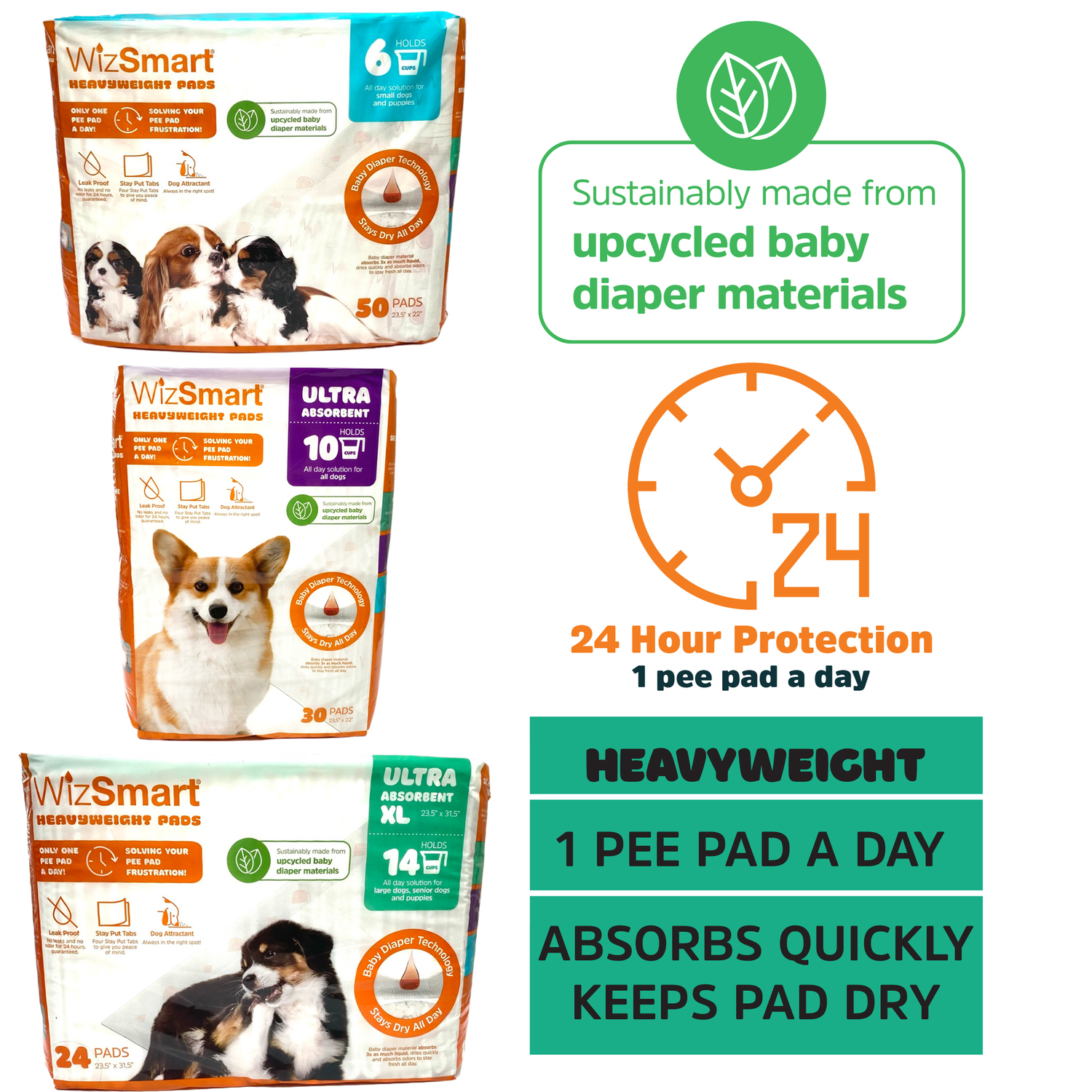
6 Steps to Help Resolve the Situation of Your Dog Peeing in the House
Older dogs are like older people - it’s sometimes difficult to get to the bathroom in time. However, incontinence in older dogs can be a sign of an underlying medical issue or disease.
What is Dog Incontinence?
By definition, dog incontinence is the involuntary leaking or dribbling of urine. What can seem like incontinence or an accident in a housebroken dog could be caused by something as simple as stress or a change of routine. However, often times it can signal a medically related problem, such as thyroid or kidney issues, a urinary tract infection or a hormonal deficiency.
If you notice a change in your older dog, either in water consumption, change in appetite and certainly evidence of dog incontinence—don’t assume it’s “old dog syndrome” or aging. Take the first step to determine whether the issue is old age, medical or stress.
Steps to Take to Address Your Dog's Incontinence
Step #1: At the first sign of incontinence and accidents in your dog, take them to the vet to rule out common canine health issues that can cause dog incontinence. According to PetMD, about “90 percent of dogs with urinary incontinence will respond to medical management.” Look for signs of these conditions to tell the vet when you see them:
A Urinary Tract Infection (UTI)
Like people, dogs - especially older dogs, can develop a urinary tract infection or UTI. This can cause dog incontinence.
Symptoms:
- Your dog may frequently pass small amounts of urine
- The urine your dog passes may be cloudy or tinged with blood
- Urethral or bladder cancer can cause similar symptoms
Diabetes, Cushing’s Disease and Kidney Disease
Different diseases, mostly related to hormones and/or organ disease, can cause your dog to drink more water and urinate more frequently, which can lead to your housebroken dog peeing in the house.
Symptoms:
- Increase in thirst and excessive thirst/increase in water consumption
- Change in appetite - increase or decrease
- Weight loss without trying to lose weight - i.e., reduction in food, more exercise
- Increased urination
- Unusually sweet-smelling or fruity breath
- Lethargy above and beyond their normal routine
- Dehydration
- Increased panting
- Pot-bellied abdomen
- Obesity
- Fat pads on the neck and shoulders
- Loss of hair
- Muscle weakness
- Infertility
- Darkening of the skin
- Thin skin
- Bruising
- Hard, white scaly patches on the skin, elbows, etc. (associated with the disease calcinosis cutis)
Thyroid Disease
Problems with your dog’s thyroid can also cause dog incontinence, as well as lethargy, weight gain, hair loss, and oily skin.
Symptoms:
- Weight gain
- Inactivity
- Intolerance to cold temperatures
- The fur or hair may become thin with excess shedding
Arthritis or Mobility-limiting Conditions
While joint problems like arthritis or bursitis don’t cause dog incontinence directly, they can make your dog reluctant to move, or go outside as often as they should, which can cause accidents. Osteoarthritis in dogs is the breakdown of cartilage and bone in your dog. While supplements can help ease the inflammation and pain, nothing can heal this condition, although making sure your dog is not obese, eats a healthy diet, and gets plenty of exercise can delay or prevent its onset. Dogs tend to hide their pain from people until the condition is severe. Once the condition is critical, you’ll notice it. Arthritis can sometimes prevent dogs from crouching enough to empty their bladder, resulting in incontinence.
Symptoms:
- Decrease in activity
- A stiff gait
- Lameness
- Tenderness in their joints
- Yelping, whining or pulling away when touched
- A decline in interest in daily activities
Neurological Conditions
As your dog ages, they can develop neurological conditions, including compressed spinal discs, that can lead to a dog who can’t control his bladder and sphincter muscles.
Estrogen Deficiency
Older female dogs can develop an estrogen deficiency which leads to dog incontinence, especially in spayed females.
Step #2: Adjust your thinking. Incontinence is never a behavioral problem, it’s a medical problem, and trying to fix your dog or punish her is a terrible idea. In fact, many dogs become quite distressed to realize they are passing urine in places other than a designated potty spot. House trained dogs often feel embarrassed and ashamed when they are ‘bad,’ [have an accident] so take your pet out often, consider doing some pee pad training, and reassure them that they’re still good dogs when they have an accident. Imagine the day when you may have the same problem and try to be compassionate and understanding with your pet.
Step #3: Increase your dog’s outdoor visits to go potty. Making sure your dog can get outside to pee as needed can often eliminate most accidents. This may mean installing a doggie door or adding a dog walk.
Step #4: Investigate alternative bathroom options such as dog diapers or dog pee pads. Change out your dog’s current bedding with washable bedding. Use waterproof pads, plastic sheeting, or other materials below your pet’s bedding to protect flooring or furniture. Your dog should only wear these things when incontinence is likely to be an issue - such as during the night.
Step #5: Keep your dog’s skin clean. Urine can irritate your dog’s skin and create more issues, so bathe or wash their inner legs and belly often to ensure caustic urine isn’t causing irritation.
Senior dogs need compassion and care when dealing with incontinence. It’s only fair to give them the same treatment you would expect if you were in their shoes. We can help with WizSmart Dog Pee Pads.


